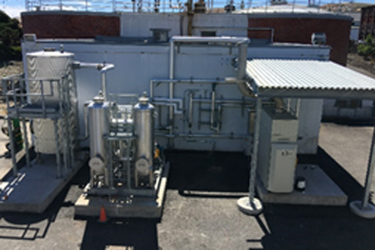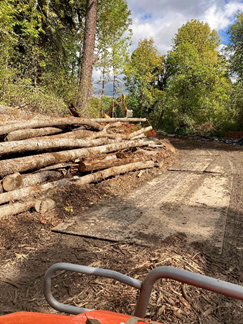The Contractor's Song: Sustainability In Construction — It's Not Easy Being Green
By Jeremy Holland

It's not easy being green
It seems you blend in with so many other ordinary things
- Kermit the Frog
With the completion of the November global climate change conference in Glasgow, Scotland, it fits to follow this up with a discussion about sustainability in construction. The Glasgow meeting, commonly referred to as COP26, is the latest in a long running conversation about climate change. The focus of this conversation is two-fold: What are the causes and consequences of climate change, and what can we do to address those causes or live with the consequences?
Construction of water infrastructure is germane to this conversation because the things we build and the processes we use to build them are contributors to climate change. Our ability to build our projects more sustainably can provide significant benefits to the global effort to reduce human caused climate change. The challenge is that building sustainably — “being green” — is not easy for a variety of reasons that are important to discuss and consider as we try to do our part.
Climate Change — Important, Like A Mountain
Climate change is the impact on the planet from industrialized human activities that results in an increase in carbon emissions into the atmosphere. This leads to long-term increases in global temperatures that change our environment. Carbon emissions, which includes carbon dioxide and an a variety of other gases that our industrialized human activities generate, exceed the natural capacity of the planet to absorb and as a result they build up in our atmosphere, acting as an insulating barrier which traps heat. Over time, this trapped heat builds up to the point that causes the planet to get hotter. This in turn causes a wide variety of impacts to the land, animals, and people on it. More heat causes ice to melt at our poles, increasing ocean levels, it results in more energy for more intense storms, and it alters the ongoing seasonal conditions which disrupt life-cycles of plant and animals. It's important to understand the causes of climate change, the results of those causes, and what we can do to reverse the impacts and manage our behaviors to limit carbon emissions in the future. Two of the areas that many people in the construction industry are now focusing on to accomplish this is reduction of operational carbon and embodied carbon.
Operational Carbon — Flashy Sparkles In The Water
Operational carbon is the most well-known and visible aspect of our emissions — think smokestacks, car exhaust, and urban smog. It is a term used to define the carbon emissions that result from operation of a building or facility after it has been completed. This form of carbon emissions has been the focus of many extensive efforts to reduce impacts. The biggest examples of operational carbon that occur across all types of construction are fuels used to provide electricity to buildings or for space heating and cooling. For water infrastructure the most significant emitters of operational carbon are energy to pump water, compressed air for operating equipment and for treatment processes, and heat for some biological processes. Many strides have been taken to improve the carbon emissions of our buildings and processes. Whether it be wind or solar renewable energy, green roofs, improved insulation, heat recovery, transit-oriented development, recycled water, or other means, we have done great things to reduce operational carbon. Water infrastructure projects have also included many of the same reductions, as well as recognizing that process optimization can reduce air demands, heat needs, and pumping requirements, and in particular with waste streams, there are valuable resources that can be recovered. Using biogas produce from anaerobic digesters to generate renewable energy, such as our project at the Dalles WWTP. This is a great example of getting the most out of a wastewater treatment plant. Historically, the challenges with reduced operational carbon have been the knowledge of design decisions that impact energy needs, the upfront costs associated with selecting “greener” technologies, and the understanding of how to operate facilities more sustainably. Fortunately, there are many methods of tracking these improvements, such as LEED, Envision, and others, which have aided the transition to more sustainable operating behaviors and the designs themselves.
Embodied Carbon — Big Like an Ocean

Renewable fuels used for construction equipment, sourcing more local materials, and reusing materials for new structures are all options on the table for reducing embodied carbon. Like operational carbon, there are also tools to better track and change the carbon footprint of our construction projects. For materials, Environmental Product Data (EPD) is documentation of carbon footprint that are available to quantify footprint more readily on projects. Resources such as the International Living Future Institute and its Living Building Challenge are available to help guide projects toward a more sustainable outcome. Again, challenges to overcome include costs, but also understanding the impact of construction activities and the time necessary to evaluate options and make choices earlier that can result in positive outcomes.
Coda — Green, It’s What I Want to Be
As a construction sector focused on water infrastructure, we generally spend our days thinking about meeting schedule and budget to deliver critical facilities that keep our water safe and clean. Adding to these job requirements an emphasis on doing the same work more sustainably can be a real challenge. But when you spend some time thinking about the purpose behind what we are building, why wouldn’t we try to be greener if we can? It only furthers the mission of building a better world, one project at a time. I got into the water infrastructure industry over 20 years ago because I wanted to make a positive impact on our environment, and its exciting to see even more attention being given to methods we can use to further push our impact. I don’t know about you, but being green is “pretty cool and friendly-like” and I can’t imagine being anything else!
 Jeremy Holland is a Market Executive in the Water Infrastructure Market in Mortenson Seattle’s Operating Group. With 23 years of engineering experience, Jeremy has served as project principal, technical advisor, project manager, and design engineer. His industry knowledge spans a wide variety of projects, clients, disciplines, and engineering problems. A licensed Professional Engineer in Oregon, WA, and Puerto Rico, Jeremy received a Bachelor of Science in Chemical Engineering and a Bachelor of Arts in English from the University of Notre Dame, and a master’s degree in Business Administration from Portland State University. He is a board member of the Oregon Association of Clean Water Agencies and is the Co-Chair of the Water Quality Committee.
Jeremy Holland is a Market Executive in the Water Infrastructure Market in Mortenson Seattle’s Operating Group. With 23 years of engineering experience, Jeremy has served as project principal, technical advisor, project manager, and design engineer. His industry knowledge spans a wide variety of projects, clients, disciplines, and engineering problems. A licensed Professional Engineer in Oregon, WA, and Puerto Rico, Jeremy received a Bachelor of Science in Chemical Engineering and a Bachelor of Arts in English from the University of Notre Dame, and a master’s degree in Business Administration from Portland State University. He is a board member of the Oregon Association of Clean Water Agencies and is the Co-Chair of the Water Quality Committee.
